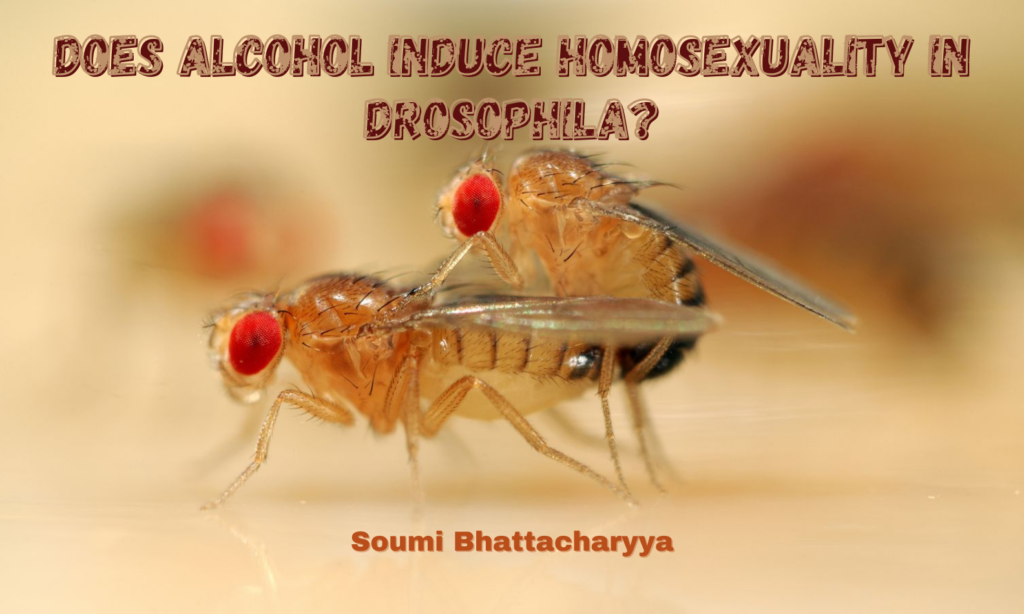
Alcohol has always had a strong relationship with humans inducing various types of behaviour, and this has time and again resulted in many fascinating findings on behavioural changes due to alcohol in the model organism Drosophila. It was during my internship-days I too got prompted to lookup more about alcohol effects on fruit-flies as I had been keenly observing very evident intermale courtships amongst Drosophila when sedated, that I finally read about some exciting findings on the same.
Substantial research investigating physiological mechanisms underlying behaviour when exposed to specific concentrations of ethanol have shown that ethanol affects fly and mammalian nervous system in a similar manner. A group of scientists from Pennsylvania State University reported that Drosophila males upon repeated exposure to ethanol displayed intermale courtship and behavioural sensitisation to this effect. They had exposed the flies to 75% and 90% ethanol and recorded their mean sedation time and activity profile to see that the flies developed tolerance upon repeated ethanol exposure due to adaptive changes in neural activities.

[MST – Mean Sedation Time]
Typically Drosophila males can be seen courting females with the usual pre-copulatory courtship ritual of following the female, wing vibration with courtship song, tapping the female abdomen and licking of female genitalia. But rarely do we observe in normal circumstances a male Drosophila following and courting another mature male. In the non-sedated state, even if a male courts another male, the courtee strongly rejects the courting male. Even in the first exposure to ethanol, the males hardly exhibit courtship behaviour. But on subsequent exposures, the males actively court other males like they generally court a female.

Another noticeable feature was that the males courted another male for hardly a few seconds to minutes and then quickly changed to court another male, and this courtship behaviour continued for around 5-10min until the flies became completely sedated and lost their motor control. Ethanol-induced intermale courtship was further quantified to conclude that Drosophila males developed behavioural sensitisation to ethanol-induced courtship behaviour. Further research implied that ethanol-induced altered male pheromones were not the reason for this homosexual behaviour. Instead certain ageing-sensitive activities might be related to the courtship disinhibition behaviour.
The group of researchers’ experimentation also suggested that the normal physiological function of Fru (a neural sex determination factor) is crucial for this behaviour. The M mutants of Fru factor exhibited intermale courtship even without ethanol exposure! M Another exciting aspect which they noticed is that visibility is also more critical for ethanol-induced intermale courtship than pheromones. They came to this conclusion as they observed that white-eyed male Drosophila (these flies have a mutation in the w allele which impairs their visibility under normal light conditions) showed almost no intermale courtship under normal light conditions and CS (wild type) males also did no show intermale courtship under infrared light conditions (wild type flies can’t see under infrared light). Their results also showed that ABC guanine/tryptophan transporter White protein which is absent in the white-eyed flies are essential for ethanol-induced intermale courtship and on increased expression of the protein results in increased courtship behaviour in the male flies. The synaptic output of dopamine was also found to be essential for intermale courtship.
The most remarkable feature that was noticed throughout these studies is that this intersex courtship upon ethanol exposure happened specifically only in males and not in females! But they also tested out that the repeated ethanol exposure did not change the sexual orientation of the male flies but just increased the sexual arousal and courtship disinhibition, as the ethanol-induced males courted both male and female flies vigorously. Although courtship activity increases on ethanol exposure, copulation decreases significantly on both initial and recurring exposures to ethanol treatment.
All these experiments gave some interesting findings on alcohol-associated sexual behaviour in Drosophila along with drawing a line of correlation with alcohol effects on human. This results of experiments on Drosophila provide substantial physiological support to impaired sexual performance and enhanced sexual arousal as alcohol intake effects in humans. Dopamine and serotonin as important components in ethanol-induced courtship disinhibition are supported by the observation that certain polymorphisms in hW (which are human homologoue of w encoding ABCG1) are linked in males to panic and mood disorders. Keeping in line with the results in the Drosophila model, dopamine plays role in behavioural sensitization effects of ethanol in mammals too. So dopamine can be concluded as a key neuromodulator for mediating the effects of ethanol in mammals with mechanisms similar to ethanol-induced behaviour in flies.
With an exciting correlation between ethanol-induced behaviour in Drosophila with those in humans and very interesting behaviour of homosexuality of male Drosophila on ethanol-induction, we can very well conclude that alcohol and Drosophila is indeed an explosive combination with many more awesome behaviours to study upon!
By,
Soumi Bhattacharyya
Department of Biology
IISER Kolkata
Reference:
About the author:

1 thought on “Does Alcohol Induce Homosexuality in Drosophila?”